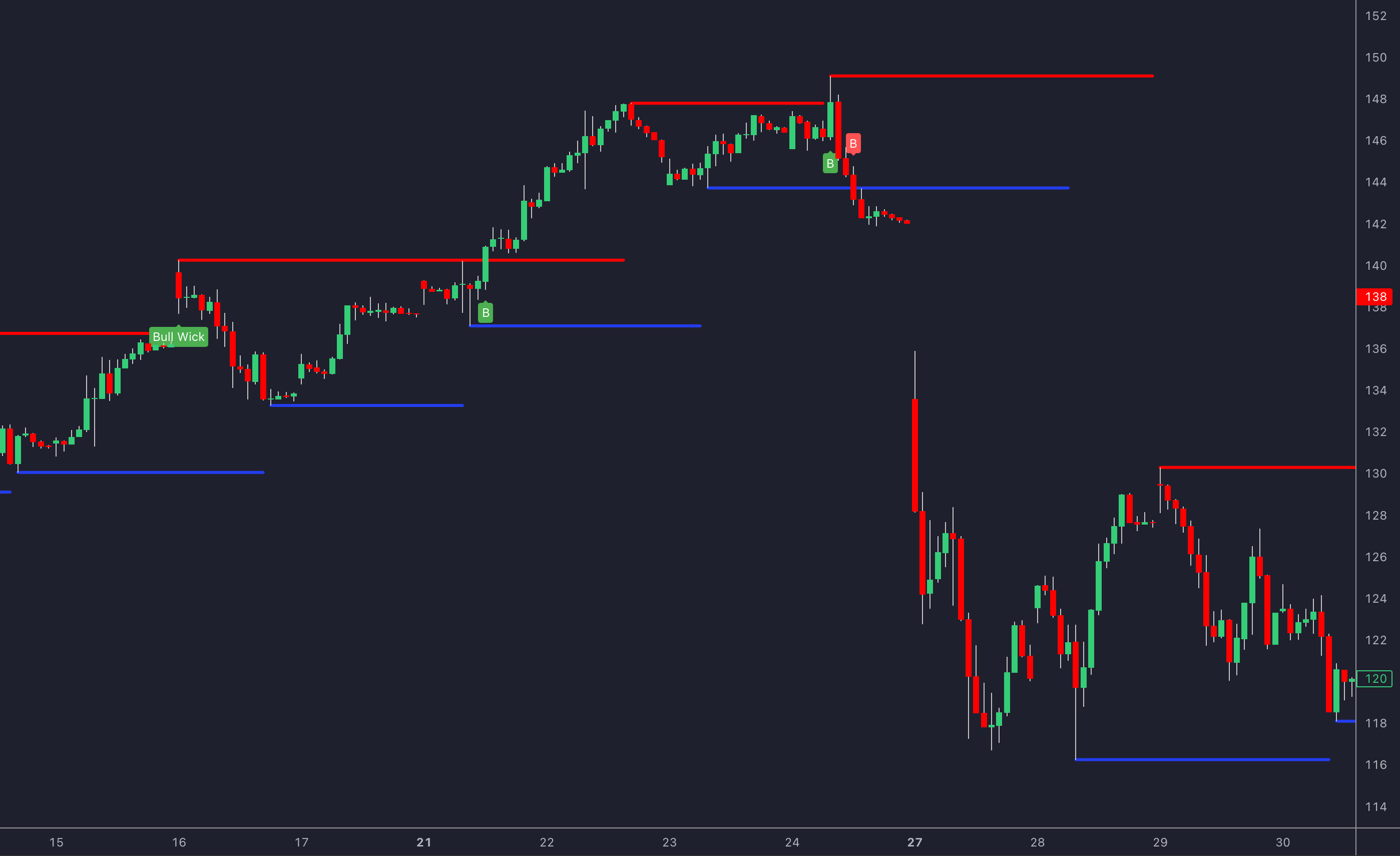Learn how to effectively use support and resistance levels for successful scalping in fast-paced trading environments.
Scalping is a fast-paced trading strategy focused on small, quick profits. The key to success? Mastering support and resistance levels. These levels act as guides for entry and exit points, helping traders spot reversals, manage risk, and make better decisions. Here’s what you need to know:
- Support Levels: Price "floors" where buying pressure prevents further drops.
- Resistance Levels: Price "ceilings" where selling pressure halts upward movement.
- How to Identify: Use price action, moving averages, pivot points, or tools like LuxAlgo.
- Risk Management: Stick to a 1:2 risk-reward ratio, place stop-losses beyond key levels, and limit trade durations to 1-5 minutes.
Understanding the Basics of Support and Resistance

What Are Support and Resistance Levels?
Support and resistance are important price levels where market trends often pause or reverse. Support acts like a floor, preventing prices from dropping further, while resistance functions as a ceiling, limiting upward price movement. These levels are identified by connecting price highs to other highs (resistance) or lows to other lows (support).
Their reliability comes from market psychology. At support levels, increased buying pressure usually stops prices from falling, while at resistance levels, stronger selling pressure tends to cap any upward movement.
How Are Support and Resistance Levels Created?
These levels emerge due to price reversals, order flow, and psychological factors. Swing points formed by reversals often turn into future support or resistance levels. Large clusters of buy or sell orders at specific price points act as natural barriers. Additionally, round numbers like $50 or $100 often hold psychological importance, influencing trader behavior.
Common Myths About Support and Resistance
| Myth | Reality |
|---|---|
| Levels are fixed | Levels adjust with changing market conditions |
| Price must touch levels exactly | Levels are better understood as zones, not exact points |
| Broken levels are invalid | Broken resistance often turns into support, and vice versa |
| More touches strengthen levels | Too many touches can actually weaken these levels |
"Support and resistance levels are a price action trader's 'best friend'. When a price action entry signal forms at a key level of support or resistance, it can be a high-probability entry scenario." - PriceAction.com [1]
For scalpers, knowing these myths can lead to smarter choices in fast-moving markets. By understanding these dynamics, traders can avoid common mistakes and make sharper decisions when dealing with these levels.
Now that we've covered how these levels are formed, we’ll move on to practical ways to identify them for scalping.
How to Find Support and Resistance Levels for Scalping
Using Price Action to Identify Levels
Price action plays a crucial role in spotting support and resistance levels for scalping. These levels often emerge where the price tends to reverse or pause, creating patterns like pin bars or engulfing candles. Such patterns give scalpers a clearer picture of potential trading opportunities, helping them act more quickly and accurately.
Tools for Identifying Support and Resistance
Modern trading platforms offer tools that make identifying support and resistance levels easier. Indicators like moving averages and pivot points are commonly used as reference points. For example, the 50-period and 200-period moving averages are widely regarded as important benchmarks. Additionally, tools like those from LuxAlgo provide visual aids that help traders cut through market noise and pinpoint these levels effectively.
| Tool Type | Purpose |
|---|---|
| Moving Averages | Tracks dynamic levels |
| Pivot Points | Offers static benchmarks |
| Price Action Tools | Identifies key patterns |
Analyzing Multiple Timeframes
To enhance scalping accuracy, start by identifying major levels on higher timeframes and then switch to lower timeframes for fine-tuning entry and exit points. Even in short-term trades, higher timeframe levels often impact price behavior. This multi-timeframe approach ensures your scalping strategy aligns with the market's broader movements.
"Support and resistance levels are a price action trader's best friend. When a price action entry signal forms at a key level of support or resistance, it can be a high-probability entry scenario." - PriceAction.com [1]
Scalping Strategies Using Support and Resistance
How to Plan Entries and Exits
Scalping relies on precise timing at support and resistance levels. Go long when the price confirms a bounce off support, and short when it gets rejected at resistance. Pair these setups with volume and momentum analysis to improve your trade execution.
| Trade Type | Entry Condition | Stop-Loss Placement | Take Profit Target |
|---|---|---|---|
| Long | Confirmed bounce at support | Below support level | Next resistance |
| Short | Confirmed rejection at resistance | Above resistance level | Next support |
For instance, in a long trade, wait for the price to confirm support before entering. Place your stop-loss just below the support level and aim for the next resistance area as your profit target.
Managing Risk in Scalping
Risk management is non-negotiable in scalping. Stick to a 1:2 risk-reward ratio and set your stop-loss just beyond support or resistance levels. Here are some key factors to consider:
- Adjust position sizes based on your account balance.
- Aim for small targets, typically 5-8 pips.
- Keep trade durations short, around 1 minute.
- Use higher timeframe levels to determine stop-losses.
While getting your entries and exits right is crucial, managing your risk effectively is what keeps you in the game over the long run.
Using Indicators for Extra Confirmation
Adding technical indicators to your strategy can help confirm setups at key levels. LuxAlgo’s advanced technical analysis features are particularly useful for identifying high-probability trades around support and resistance.
Some effective indicator combinations include:
- Moving averages to confirm trends.
- Stochastics to gauge momentum.
- Bollinger Bands to measure volatility.
When used alongside strong support and resistance zones, these indicators can boost your confidence in trade execution while keeping price action as the primary focus.
"Trading is a probability game where you must play with the most probable setups with least possible loss and maximum gains." - Anonymous, Intraday Trader [2]
Advanced Scalping Methods with Support and Resistance
Adjusting to Market Conditions
Scalping strategies need to be fine-tuned based on market conditions, especially during periods of high volatility or low liquidity. Here's a quick breakdown of how you can adjust your approach:
| Market Condition | Strategy Adjustment | Risk Management |
|---|---|---|
| High Volatility | Use wider stop-losses and shorter timeframes | Reduce position size by 25-50% |
| Low Liquidity | Focus on range-bound trading, hold positions longer | Set higher profit targets |
| Trending Market | Trade in the direction of the trend during pullbacks | Use trailing stops to capture larger moves |
For high-volatility scenarios, consider using the Average True Range (ATR) to set stop-loss levels that align with market fluctuations, while keeping your overall risk under control. Fine-tuning your strategy ensures that support and resistance levels remain reliable, even when the market becomes unpredictable.
"If you have the ability to dedicate set hours each day and the discipline to trade your strategy without emotion, scalping can be a great opportunity for you." - Pepperstone AE [1]
While adapting to the market is essential, steering clear of common errors can make or break your scalping success.
Avoiding Mistakes in Scalping
Mistakes can quickly erode profits, so it's essential to stay vigilant. Here are some frequent errors to avoid when scalping support and resistance levels:
- Overtrading at Key Levels: Limit yourself to around five high-quality trades per day. Look for confirmation signals like strong price rejections or volume spikes before entering positions.
- Ignoring the Bigger Picture: Use tools like LuxAlgo's AI-powered trend analysis to gauge the overall market direction. This helps you avoid trading against the prevailing trend, boosting your chances of success.
- Weak Risk Management in Volatile Markets: During heightened volatility, rely on tools like longer moving averages to filter out noise. Adjust RSI thresholds and confirm trades across multiple timeframes to stay on the right track.
Tips and Tools for Better Scalping
Setting Up Charts for Scalping
An effective chart setup is essential for scalping with support and resistance levels. Your charts should include key components that simplify analysis while keeping things clear and actionable [1][2].
| Chart Component | Purpose | Recommended Settings |
|---|---|---|
| Price Action & Moving Averages | Core analysis and trend confirmation | Candlestick charts, 20 EMA, 50 SMA |
| Volume | Trade validation | Displayed below the price chart |
| RSI | Momentum confirmation | 14-period default |
Avoid cluttering your workspace with unnecessary indicators that might cause confusion or slow down your decision-making. Organize your tools for quick access to keep up with the fast pace of scalping. Once your charts are set up, advanced tools can further enhance your efficiency.
How LuxAlgo’s Signals & Overlays Toolkit Offers a Scalper Preset for Scalping
LuxAlgo’s Signals & Overlays Toolkit offers a dedicated scalper preset that is perfect for traders looking to scalp markets. This preset is designed to highlight key support and resistance zones in real-time, allowing traders to react swiftly to market movements. By leveraging this toolkit, traders benefit from automated alerts and streamlined market analysis, enabling more efficient decision-making. Discover more about this innovative solution at LuxAlgo.com.
Improving Scalping Over Time
Scalping success depends on continuously improving your strategy. Use a structured method to track your performance and make adjustments:
| Metric to Track | Target Range | Action if Below Target |
|---|---|---|
| Win Rate | Above 50% | Reevaluate entry criteria |
| Risk/Reward | At least 1:1 | Adjust profit targets |
| Average Trade Duration | 2-5 minutes | Fine-tune exit rules |
Keep your position sizes consistent relative to your account balance. Review your trades weekly to spot trends in what’s working and what’s not. Regular performance reviews will help you refine your support and resistance-based scalping approach, leading to steadier results over time.
Conclusion: Using Support and Resistance for Scalping Success
Support and resistance levels are central to effective scalping strategies. The best scalpers focus on these levels within shorter timeframes (M5-M15) while cross-checking them against higher timeframe structures for added reliability.
Here's how scalpers put support and resistance into action:
| Aspect | Implementation | Key Benefit |
|---|---|---|
| Entry Timing | Look for price action signals at key levels | Increases chances of success |
| Risk Management | Set stops beyond tested support/resistance | Limits potential losses |
| Trade Duration | Hold trades for 2-5 minutes on average | Minimizes exposure to volatility |
| Level Validation | Use multiple timeframe analysis | Confirms key levels more effectively |
Modern trading tools make scalping easier by automating the identification of support and resistance levels. Tools like LuxAlgo streamline this process, helping traders concentrate on executing their strategies rather than manually pinpointing levels.
To excel at scalping with support and resistance, focus on these key elements:
- Disciplined execution: Only act on confirmed price action signals.
- Volume analysis: Use volume to validate trade setups.
- Risk control: Stick to consistent risk management rules.
- Mental readiness: Be prepared for quick decisions in fast-moving markets.
- Position sizing: Adjust trade sizes in line with your account balance.
These guidelines build on the strategies covered earlier, highlighting the need to combine technical insights with solid risk management. Prioritize trading during times when support and resistance levels are most reliable, and align this with your broader market timing approach.
FAQs
What is the most profitable 1-minute scalping strategy?
There’s no guaranteed way to make consistent profits, but successful 1-minute scalping often involves using a mix of technical tools around support and resistance levels. Here's a quick breakdown:
| Tool Type | Function | Application |
|---|---|---|
| Price Action | Core analysis | Spot reversals at key price levels |
| Volume | Confirmation | Confirm breakouts or rejections |
| Technical Tools | Signal generation | Identify high-probability setups |
To maximize success, combine these tools with solid risk management and focus on trading during high-liquidity times. This is when support and resistance levels tend to be most reliable.
What is the most accurate indicator for support and resistance?
Instead of sticking to just one indicator, combining several tools gives better results for pinpointing support and resistance levels. Some popular options include:
- Fibonacci Levels: Great for spotting potential reversal points.
- Moving Averages: Help create dynamic zones for support and resistance.
- Pivot Points: Offer clear price levels based on past trading ranges.
For those who want to streamline the process, LuxAlgo’s advanced toolkits can automate these tasks, making it easier to focus on execution.
"Fibonacci levels are one very popular set of indicators used widely in determining support and resistance. Many traders also make heavy use of moving averages when determining support and resistance level, and pivot points are also quite popular."








